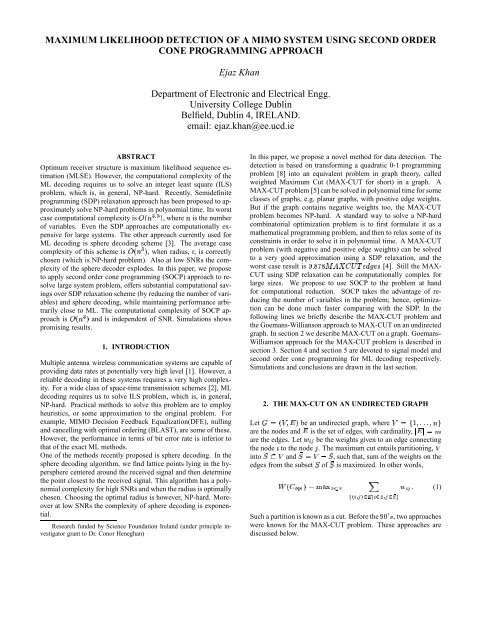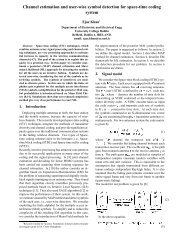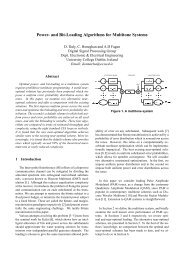Maximum likelihood detection of MIMO system using second order ...
Maximum likelihood detection of MIMO system using second order ...
Maximum likelihood detection of MIMO system using second order ...
Create successful ePaper yourself
Turn your PDF publications into a flip-book with our unique Google optimized e-Paper software.
VMAXIMUM LIKELIHOOD DETECTION OF A <strong>MIMO</strong> SYSTEM USING SECOND ORDERCONE PROGRAMMING APPROACHEjaz KhanDepartment <strong>of</strong> Electronic and Electrical Engg.University College DublinBelfield, Dublin 4, IRELAND.email: ejaz.khan@ee.ucd.ieABSTRACTOptimum receiver structure is maximum <strong>likelihood</strong> sequence estimation(MLSE). However, the computational complexity <strong>of</strong> theML decoding requires us to solve an integer least square (ILS)problem, which is, in general, NP-hard. Recently, Semidefiniteprogramming (SDP) relaxation approach has been proposed to approximatelysolve NP-hard problems in polynomial time. Its worstcase computational complexity is¢¡¤£¦¥¨§©, where£is the number<strong>of</strong> variables. Even the SDP approaches are computationally expensivefor large <strong>system</strong>s. The other approach currently used forML decoding is sphere decoding scheme [3]. The average casecomplexity <strong>of</strong> this scheme is¢¡¤£ ¥ , when radius, r, is correctlychosen (which is NP-hard problem). Also at low SNRs the complexity<strong>of</strong> the sphere decoder explodes. In this paper, we proposeto apply <strong>second</strong> <strong>order</strong> cone programming (SOCP) approach to resolvelarge <strong>system</strong> problem, <strong>of</strong>fers substantial computational savingsover SDP relaxation scheme (by reducing the number <strong>of</strong> variables)and sphere decoding, while maintaining performance arbitrarilyclose to ML. The computational complexity <strong>of</strong> SOCP approachis¢¡¤£¦¥and is independent <strong>of</strong> SNR. Simulations showspromising results.1. INTRODUCTIONMultiple antenna wireless communication <strong>system</strong>s are capable <strong>of</strong>providing data rates at potentially very high level [1]. However, areliable decoding in these <strong>system</strong>s requires a very high complexity.For a wide class <strong>of</strong> space-time transmission schemes [2], MLdecoding requires us to solve ILS problem, which is, in general,NP-hard. Practical methods to solve this problem are to employheuristics, or some approximation to the original problem. Forexample, <strong>MIMO</strong> Decision Feedback Equalization(DFE), nullingand cancelling with optimal <strong>order</strong>ing (BLAST), are some <strong>of</strong> these.However, the performance in terms <strong>of</strong> bit error rate is inferior tothat <strong>of</strong> the exact ML methods.One <strong>of</strong> the methods recently proposed is sphere decoding. In thesphere decoding algorithm, we find lattice points lying in the hyperspherecentered around the received signal and then determinethe point closest to the received signal. This algorithm has a polynomialcomplexity for high SNRs and when the radius is optimallychosen. Choosing the optimal radius is however, NP-hard. Moreoverat low SNRs the complexity <strong>of</strong> sphere decoding is exponential.Research funded by Science Foundation Ireland (under principle investigatorgrant to Dr. Conor Heneghan)In this paper, we propose a novel method for data <strong>detection</strong>. The<strong>detection</strong> is based on transforming a quadratic 0-1 programmingproblem [8] into an equivalent problem in graph theory, calledweighted <strong>Maximum</strong> Cut (MAX-CUT for short) in a graph.MAX-CUT problem [5] can be solved in polynomial time for someclasses <strong>of</strong> graphs, e.g, planar graphs, with positive edge weights.But if the graph contains negative weights too, the MAX-CUTproblem becomes NP-hard. A standard way to solve a NP-hardcombinatorial optimization problem is to first formulate it as amathematical programming problem, and then to relax some <strong>of</strong> itsconstraints in <strong>order</strong> to solve it in polynomial time. A MAX-CUTproblem (with negative and positive edge weights) can be solvedto a very good approximation <strong>using</strong> a SDP relaxation, and theworst case result is "!#%$ [4]. Still the MAX-CUT <strong>using</strong> SDP relaxation can be computationally complex forlarge sizes. We propose to use SOCP to the problem at handfor computational reduction. SOCP takes the advantage <strong>of</strong> reducingthe number <strong>of</strong> variables in the problem; hence, optimizationcan be done much faster comparing with the SDP. In thefollowing lines we briefly describe the MAX-CUT problem andthe Goemans-Willianson approach to MAX-CUT on an undirectedgraph. In section 2 we describe MAX-CUT on a graph. Goemans-Williamson approach for the MAX-CUT problem is described insection 3. Section 4 and section 5 are devoted to signal model and<strong>second</strong> <strong>order</strong> cone programming for ML decoding respectively.Simulations and conclusions are drawn in the last section.2. THE MAX-CUT ON AN UNDIRECTED GRAPH¡*),+.-/be an undirected graph, where)'(021 + 33 +4£65are the nodes andisthe set <strong>of</strong> edges, with cardinality,7-7'8Let&('are the Let9:; edges. be the weights given to an edge connectingnode< the to node= the . The maximum cut partitioning,)entailsedges from subset> the A > <strong>of</strong> is maximized. In other words,)and A >B' )DC > , such that, sum <strong>of</strong> the weights on theinto>@?E ¡GFIH"J 'LKNMOQPSRUTSuch a partition is known as a cut. Before theefg$ , two approacheswere known for the MAX-CUT problem. These approaches arediscussed below.AX:¤Y;¨Z\[2]_^:\[PY;[a` Pcb 9d:;c (1)Ẅ
AV- A: - ; 7790¡QWWW- A: - ; 7790¡QJ)ZJ ' Z)2.1. Two approachesOne approach, the Greedy Approach, works as follows: choose anode arbitrarily, and add to> it . Then for each node£remaining ,if the sum <strong>of</strong> the from£weights to the nodes in current> the areless than the sum <strong>of</strong> the from£weights to the nodes in the current, add£to> ; otherwise, add it to A > . LetE ¡¡ £¢¥¤¦¤¨§£©denote thevalue <strong>of</strong> this cut. It can be shown that:> E ¡ FIH"J (2)E ¡ ¢¥¤¦¤¨§£©A <strong>second</strong> approach, the Randomized Approach, works by>ran-. Let us denote the value <strong>of</strong>Z*[] 9 :;X:\Y;domly assigning nodes > to A andthe cuts generated in this fashion byE ¡¢§. It is shown that-E ¡ ¢¥§' VX:\Y; Z 9d:; (3)Until the early ef¤$ , it was not known whether this factor <strong>of</strong> could be improved.3. THE GOEMANS-WILLIAMSON APPROACHGoemans-Williamson [4] approached the problem as +=# A > or vice-versa otherwise1So then the objective becomes to $ :\Y;&%('*) +¡ 1 Cmaximizewith less complex problem, Goemans and Williamson consideredthe following relaxation. Associate to each vertex A&I ¡ 1CON£P$M:; to is . Clearly,M:; the closer Q is to , the larger this contribution will be. In turn,we would like : vertices and ; to be separated if M :; is large.The following method accomplishes precisely this. Pick - to be- Ra uniformly distributed vector on the unit sphere > 5< :and let0 - : 7 F : R 5. Observe now that the probability that thevectors - : and - ; are on the opposite sides <strong>of</strong> the hyperplane is>('exactly the proportion <strong>of</strong> the angle between : and - ; to Q , i.e.,7790%¡ - - - ; Q . Let the cut generated by the random hyperplanebeE ¡ ¢§ P5TU(see figure). Then by linearity <strong>of</strong> expectations:MSSince the expected value <strong>of</strong> the given cut is at most as large asthe optimal cut, and since the expected value <strong>of</strong> the optimal cut isless than the value <strong>of</strong> the semidefinite relaxation, we have-E ¡ ¢§ P5TU' V:¤Y;MS(6)' -;: + 33 + - )@ ')BA )Let , and let us @ index C :; +
A¨+'WWWM+=W CM6MWby C¢' - A: - ; renaming , we see that such an Y' K¡ £¢< :¥¤ © ¤L:Y MSat most equalsQ¡ 1 CC (9)In <strong>order</strong> to minimize the last expression, we convert MAX-CUT problem into following quadratic problemThis minimum is approximately% as shown in [4].7790"¡§¦SK¡ £¢ K¡ £$013254¦678/8¥9 A ; A4. SIGNAL MODELWe consider BPSK case. We assume a discrete time block fadingmultiple antenna channel model D with transmit and receiveantennas, also we assume that the receiver has perfect channelknowledge. The received signal at an instant isA ¡IC ; A; A non-convex quadratic constraint problem is given byK¡ %¢& K¡ %$6 N A (17)R¨HW+,+' 1+.-/-/- + 8 (18)W1 + = ' 1 + ¨3 +4£C 1 + = ' 1 + ¨3 +4£; C AAwhere ¨ .is a known channel matrix, and£ . '©¨ $" £ +(10)>is the i.i.d. zero mean white Gaussian noise with variance . Thefading coefficients are i.i.d. Gaussian with zero mean and unitvariance. Under the aforementioned assumptions, the ML criterionrequires us find$ . > :to C¨minimizesML <strong>detection</strong>.$ > :, where $ : 0 C 1 + 1 5, which. Now we develop SOCP method for the5. SOCP ML DECODERThe problem can be written (after neglecting constant term) aswhere and N '©¨' C¨6¡$ '$ . Since [ W < : Y : b$A$"KNMON A$ +(11)+: 'D$ : + < +(12)$are the diagonal entries in J, can be absorbed in the vector . ThusNwithout loss <strong>of</strong> generality, we can assume that all diagonal entries<strong>of</strong> are zeros. The above equation is equivalent towhere Ais <strong>of</strong> the formA6¡$ ' 8=F © [ W < : Y : b Y © ¥ N NA: CAAC (13)(14)Since this cost function is symmetric, C : ' 1 need not bemaintained explicitly. It can be shown that the MAX-CUT problemis equivalent to ML <strong>detection</strong> with BPSK [9]. As mentionedearlier that the MAX-CUT problem is NP-hard, therefore we willuse some relaxation scheme to find near optimum solution. In thisrespect, note that ; ' 1PC1! +; ' 1#" +;W1 + +;1 (15)RA ; A; 1 + A ¡IC ; A; C 1 (16) ; where is all zero vector except 1 position= at . MaximizingAA implies minimizing M subject toC AA where ' H > ¡¤£¦ + N A('H "*) AH "01?2;4¨678/8¥9set <strong>of</strong> real symmetric matrices. The above problem can be writtenasN5464¦P R¡ 'H "*) AH "$.234= . , ) H . and R H . . > ¡¤£6is the P8 + R¡>= (23)then the right hand side <strong>of</strong> the above equation alsoimplies the left hand side. A convex quadratic constraint can nowR¡4¡ C ( A ¡ (24)P8 +which are convex quadratic constraints. If' > ¡¤£¦ be easily transformed into <strong>second</strong> <strong>order</strong> cone constraints. To d<strong>of</strong>or P8 this, we decomposeD'D Afirst , where =.(>&?and 7is symmetric and positive semidefinite. The constraint(25)' RF£87U¡ . Such a decomposition is always possible, asis equivalent toIt is known that anyR¡ A (26)A A R¡ (27)W +F£!A@+CB/.+(28)9ZE.
¢¢''V¨§¢R¨HWRV¢+6 N A ¨§ +AAV'AV"V : ; 0 ; CMR6RMcan be written as [6,7],9A9¡ @B+@ + B# (29)2c;.2Summing then up eq (36) and eq (40), we produce a new ( weaker)inequality A; C R¡2; 2; W + =/'"1 + ¨3 +4£ (41)¢¢¢C B@9 W ¢Where the norm is Euclidean. If we take¢¢¢B "@ (30)' A + B' 1 + M ¢¤£ @¢' R¡ +(31)9we can convert the inequality,into the following linear inequality with an additional <strong>second</strong> <strong>order</strong>cone condition [6], A A W R¡ +(32)(33)A(' R¡V ": ;.2c; 2 ;; " ) A " AW (42)+ satisfies eq (36) and eq (40), then it also satisfies eq (42),If¡but the converse is not generally true. Putting0 ; ' R¡2c;.2; + A(43)we obtain the following convex quadratic constraints A ' " : ; 0 ;"*) A "W (44)where" R 1 C R¡ ¥¦1A ©¡R ' /.7¡ L: ¢+; (34) ;is the <strong>second</strong> <strong>order</strong> cone. This is the basic idea <strong>of</strong> the SOCP relationfor the non-convex quadratic programming. The final form <strong>of</strong>SOCP is as follows.; A2 ; C0 ; + = '"1 + 33 +4£(45)W2;where inequality (45) are the <strong>of</strong>£ C relaxed version equalities.The advantage <strong>of</strong> this method is that we can reduce the number<strong>of</strong>¢¡¤£ + variables from to the total the£ C number smallesteigenvalues H $ <strong>of</strong> . On the other hand, the inequality eq (44) andeq (45) are weaker than the original constrainst, i.e., eq (36), eq(40) and eq (41). In fact, if we do not impose an upper bound ';on, than any can satisfy eq (44) and eq (45) with large 0 ; $ (note 0©¡ 7 "013254¦678/8¥9 ¡ 'H% " ) AH "RK¡ %¢& K¡ %$+ +' 1 + 33 + 8that ; O= ). Therefore, we require some restriction on 0 ;in advance. Using the technique described above, we can convertthe MAX-CUT problem, eq (17), into SOCP for MAX-CUT asK¡ £¢ K¡ £$¥¦1" R¡ 1 C R¡ A ©¡RF£87 ¡ "C A 013254¦678=8¥9(35)P8 + ' A + The above SOCP¢¡¤£ + has variables. Now we use the techniqueexposed in [6] to further relax the constraints. We now describetheir method. From now for the sake <strong>of</strong> simplicity we omit thesubscript and consider the linear inequality+Let R¡ ' " ) A "W (36);A(37)where A );) A; W C0 ;W + =/'"1 + "3 +4£ A;; AW1 + = ' 1 + "3 +4£ ; V ; '; V :0 ;W£ +(46););) A; +(47):;.2c; 2:be the spectral decomposition <strong>of</strong> Q, where ; are the eigenvalues2c; and are the corresponding eigenvectors. Without loss <strong>of</strong> generality,we assume thatand put: 33we can further write' ¤; V ; '¤ : : ; 2 ; 2 A ' C R¡ ' 33+(38); + A(39)W (40)with: + ¨3 ;;);) A; +(48): It is straight forward to derive the last constraint in (46) boundfrom expression (43) : + "¨+ (49)0 ; ' R¡ );) A; (50)The above SOCP MAX-CUT can be solved very efficiently byprimal-dual interior point method [10].
6. CONCLUSIONSIn this paper, we proposed a new ML <strong>detection</strong> method for the<strong>MIMO</strong> channel. This method is based on relaxing the MAX-CUT problem and solving the resulting <strong>system</strong> by SOCP. We haveshown that the MAX-CUT (equivalently ML <strong>detection</strong>) problemcan be formulated into SOCP problem. The advantage <strong>of</strong> the proposedmethod over the SDP relaxation is that the difference in thenumber <strong>of</strong> variables between SDP relaxation and SOCPas£increasesbecomes large. Hence MAX-CUT SOCP is numerically moreefficient. Although, in general, the lower bound computed bySOCP relaxation is not as good as a bound obtained with SDPrelaxation in theory, they are <strong>of</strong>ten close to each other [6]. Theproposed method has three significant advantages over the spheredecoding technique.1) The proposed method is polynomial time irrespective <strong>of</strong> thevalue <strong>of</strong> the SNR as opposed to sphere decoding which has exponentialcomplexity for low SNR values.2) The SOCP has no heuristic parameters to set (unlike the spheredecoder in which the optimal radius has to be selected in a heuristicway).3) The sphere decoder complexity,¢¡¤£ ¥ , is at each time instant,while there is no such problem in SOCP approach.Moreover our approach does not require number <strong>of</strong> the receive antennasto be greater than number <strong>of</strong> the transmit antennas as theBLAST receiver does. Simulations results in figure 2 shows thatSOCP gives very close approximation to the exact ML and thatthere is almost no difference between the performance <strong>of</strong> the SDPand SOCP method. Simulations are performed for two transmitand two receive antennas. In general for large£the saving <strong>of</strong> CPUtime gets larger for SOCP in comparison to SDP method.[2] G.J. Foschini, ”Layered space-time architecture for wirelesscommunication in a fading environment when <strong>using</strong> multielementantenna ”, Bell labs Tech. Journal, vol.1, no.2, pp.41-59, 1996.[3] H. Vikalo and B. Hassibi, ”<strong>Maximum</strong> <strong>likelihood</strong> sequence <strong>detection</strong>for multiple antenna <strong>system</strong> over dispersive channelsvia sphere decoding ”, Eurasip Journal on App. Signal Processing, no.5, pp.525-531, May, 2002.[4] M.X. Goemans and D.P. Williamson, ”Improved approximationalgorithms for maximum cut and satisfiability problems<strong>using</strong> semidefinite programming ” Int. Journal <strong>of</strong> ACM, no.42,pp.1115-1145, 1995.[5] B. Mohar and S. Poljak, ”Eigenvalues and max-cut problem”Czechoslavak mathematical journal, no.40, pp.343-352, 1990.[6] S. Kim and M. Kojima, ”Second <strong>order</strong> cone programming relaxation<strong>of</strong> non-convex quadratic optimization problems” Optimizationmethods and s<strong>of</strong>tware no.15, pp.201-224, 2001.[7] M.S. Lobo, L. Vandenberghe, S. Boyd and H. Lebret, ”Applications<strong>of</strong> <strong>second</strong> <strong>order</strong> cone programming, Tech. report January31, 1998.[8] C. Helmberg and F. Rendl , ”Solving quadratic (0,1) problemsby semidefinite programs and cutting planes”, Mathematicalprogramming, vol.82, pp. 219-315, 1998.[9] M. Junger and G. Rinaldi, ”Relaxation <strong>of</strong> Max-Cut problemand computations <strong>of</strong> spin glass ground states”, Tech. reportno. 97.300, 1997.[10] Y. E. Nesterov and A. S. Nemirovskii, ”Interior point polynomialalgorithms in convex programming”, SIAM studies inApplied Mathematics, SIAM, Philadelphia, PA, 1994. .10 0BER versus SNRexact MLSDP MLSOCP ML10 −1BER10 −210 −310 −40 0.5 1 1.5 2 2.5 3 3.5 4 4.5 5SNR in dBFig. 2. Av. BER for N=2, M=2 vs ¢¡¤£¦¥¨§©¦ .7. REFERENCES[1] I.E. Talatar, ”Capacity <strong>of</strong> multi-antenna Gaussian channels ”,European Trans. on Telecommunications, vol.6,no., pp.585-595, no.11, 1999.




